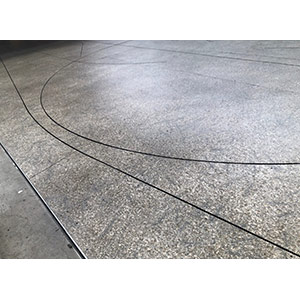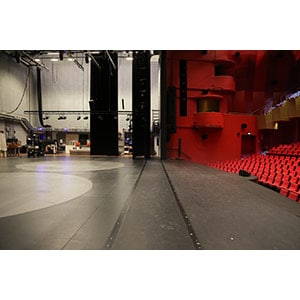Move
Because purple just performs better
In theatre and other productions needing technical solutions, different drives, such as winches, chain hoists, linear actuators and friction drives, are required for different uses. When choosing the most appropriate drive, a balanced decision based on application, specification and price must be made.
Chain hoist – v – winch
Winches are generally preferable to chain hoists because, for the purposes of scene changes in a show, they are quick and quiet. Winches are also more economical if more than one lifting point is required. In this case, a multi-wire drum can be used instead of several chain hoist motors.
Line shaft winch
Line shaft winches are suitable for locations where there is no grid and, therefore, no mounted pulleys. The drawback is that hanging from a ceiling point is not easy for maintenance purposes. Another disadvantage is that the line shaft winches require a lot of space. It may be difficult to find sufficient space given that the fly bars may be approximately 200mm apart. Furthermore, the cable moves along the load-bearing drum. Compensation is achieved through adjacent drums which have the cable wrapped in opposing directions. An unequal load may result in an s-shaped bar instead of a straight bar.
Pilewind winch
Pilewind winches are cheaper but the length of the adjacent cables does not remain constant. This means that when, for example, there are more than three runs of cable, there may be an unequal load. The wear on the steel cables is also greater.
Vertical winch
Vertically mounted winches take up less floor space but require a costly mechanism to ensure zero fleet.
Vertical winch with a slim drum
A vertical winch with a small drum diameter can fit into a narrower area, but can be up to three times longer. This type of winch can often be seen hanging vertically from beams or fixed to the wall, but this can reduce the available width of the stage. The winch can also be installed within a truss.
The disadvantage of this arrangement is a reduction of the SWL since the winch has to hoist its own load.
Alternatively the winch can be seen hanging from a horizontal beam, which is unsuitable for maintenance.
Counterweight Assist Winch
This type of winch is a good choice financially, especially for long-term fixed productions, and if there is an old mechanical fly wall. However, on a touring production or in a receiving theatre, this means a great deal of work during the load-in as the counterweights will need changing. (In the Netherlands, the Working Conditions Act generally prohibits the use of the winch in these circumstances).
Horizontal winch
This winch is sometimes called the “Standard Power-fly Winch” (as opposed to the counterweight assisted solution). Depending on the lifting height and the associated wraps on the drum, the minimum distance from the drum to the first pulley should be considered as well as the maximum fleet angle. This requires a relatively large diameter drum. The winch is therefore shorter. As the drum get larger, so the engine and gearbox will need to increase. This becomes more expensive and, potentially, diminishes the flying accuracy.
Overcapacity and / or touring system
This system can be adapted precisely as required – which is especially useful for open-ended productions. For touring, the system needs to be robust and easy to install. A fixed installation requires flexibility to meet all the demands of the visiting companies. It must be calculated to an optimum level so that it can exceed the requirements of any production. Furthermore, the system must be fast for programming and load-in purposes.
Friction and pinch drives
Friction drives are simple in structure, competitively priced and have a great range in the absence of a mechanical hard link. The disadvantage is that there is potential slip and the repeatability accuracy is not high so this can entail safety risks.
Linear actuators
Linear actuators can work reciprocally with winches or friction drives, but can also operate as a single system.
For horizontal linear actuators there is often a winch or, at lower speeds, a tooth belt. A hydraulic cylinder is a lifting device often used for moving very heavy loads. However, increasingly, a push chain or spiral-lift are used. A worm drive (a threaded drive shaft) is very economical, but the installation is not always technically possible. Furthermore, use of the worm drive can limit the speed.
Linear motors are accurate and fast but have a relatively small stroke. Pneumatic cylinders are often used when working with limits.
| Afbeelding | Type | Uitvoering | Remark |
|---|---|---|---|
 | lier | scenisch 1-of meerdraads, powerfly of counterweight assist. Preset Performerfly | incl pulleys en roede |
 | kettingtakel | on/off & servo control | Tevens SIL3 |
 | traveltrack | tandriem of staalkabel | recht of gebogen |
 | decktrack | tandriem of staalkabel | incl compleet showdeck |
 | lift | Show: man-, kolom-, special- Toneel: goederen-, vrachtwagen-, toneel-, orkestbak lift. | Hydraulisch, lier, spira, duwketting |
 | revolve | center, donut, combi excentrisch | friction, pinch |
 | trucks | combinatie opties: crane, tilt, rotate, lift, turn, roll | friction, decktrack |
 | travellator | combinatie optie met lift & tilt | |
 | Illusionist effects | ….is ons geheim….. |
